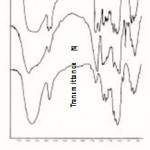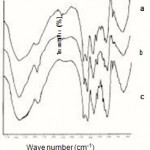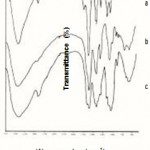How to Cite | Publication History | PlumX Article Matrix
Heterogeneous Derivatization Of Bacterial And Plant Cellulose
Sherif M. A. S. Keshk and Abdalla M. A. Nada*
1Biological and Physical Sciences Department, Institute of Environmental Studies and Research Ain Shams University, Abbassia 11566, Cairo (Egypt). 2Cellulose and Paper Department, National Research Center, Dokki, Cairo (Egypt)
ABSTRACT: Heterogeneous derivatizations, e.g. carboxymethylation and cyanoethylation were performed on bacterial cellulose (BC), viscose grade pulp and cotton linters (plant celluloses) to reveal their chemical reactivity. IR spectroscopy of these derivatives revealed that the relative absorbance of ether linkage in BC is of lower value than that of viscose grade pulp and cotton linters. This indicates a lower degree of polymerization (DP) in BC than in the other two kinds of cellulose, which reflects the higher reactivity of BC toward cyanoethylation and carboxymethylation.
KEYWORDS: Bacterial cellulose; Gluconacetobacter xylinus; Viscose grade pulp
Download this article as:| Copy the following to cite this article: Keshk S. M. A. S, Nada A. M. A. Heterogeneous Derivatization Of Bacterial And Plant Cellulose. Biosci Biotechnol Res Asia 2003;1(1) |
| Copy the following to cite this URL: Keshk S. M. A. S, Nada A. M. A. Heterogeneous Derivatization Of Bacterial And Plant Cellulose. Biosci Biotechnol Res Asia 2003;1(1). Available from: https://www.biotech-asia.org/?p=3370 |
Introduction
Cellulose is one of the most abundant organic substances on the earth. Cellulose is of great importance in fundamental research and industrial applications1. Unlike the cellulose from plant, cellulose produced by an Acetobacter strain is devoid of other contaminating polysaccharides and its isolation and purification are relatively simple, not requiring energy- or chemical-intensive processes.Very few genera of bacteria can synthesize cellulose, but the gram-negative bacterium Gluconacetobacter xylinus (Formerly known as Acetobacter xylinum) secretes large quantities of cellulose as microfibrils from a row of synthetic sites along the longitudinal axis of the cell 2,3. Extracellularly synthesized bacterial cellulsoe (BC) differs from plant cellulose with respect to its high crystallinity and purity (free of lignin and other biogenic products), high water-absorption capacity and better mechanical strength4. The typical properties of BC have also inspired investigations on the reactivity and availability of the hydroxyl groups for chemical reactions as well as the subsequent characterization of the products obtained. In our work, the IR spectrascopies of BC, viscose grade pulp and cotton linter are investigated. On the other hand, the activity of these different kinds of celluloses toward cyanoethylation and carboxymethylation are studied.
Material and Methods
The raw materials used in this study were BC, viscose grade pulp and cotton linter. The chemicals used throughout this work were purchased from Sigma and Aldrich Chemical Co. Acrylonitril and Monochloroacetic acid used in this work were deliverd from Sigma and used without further purification. American type culture collection (ATCC) is the supplier of the Gluconacetobacter xylinus. Nitrogen content in samples (In case of cyanoethylation) was performed in the Unit of Microanalyses, Cairo University, Egypt. The IR spectra on Horiba FT-210 infrared spectrometer and Degree of substiutition were recorded5,6.
Pellicles Production and Purification
The bacterial cellulose (BC) pellicles used were produced by Gluconacetobacter xylinus ATCC 10245 over a cultivation in Schramm-Hestrin (SH) medium7 and incubated statically at 28°C. The pellicles produced at the surface of the medium were harvested after 7 days and immersed into 2% sodium dodecyl sulfate (SDS) aqueous solution and washed under ultrasonication in 1% (W/V) aqueous NaOH followed by neutralization by the addition of 1%(V/V) acetic acid. Finally, pellicles were rinsed extensively with distilled water.
Cyanoethylation
2 gm of cellulosic materials (BC, viscose grade pulp and cotton linters) were stirred in 30 ml acetonitrile using magnetic stirrer at room temperature. Then 60 ml of NaOH (20%) were added over a period of 15 min. The mixture was stirred in a water bath for 2h at 60°C, after filtration, the product was washed with acidified ethanol, then dried under vaccuum. The nitrogen content and the infrared (IR) spectra of the derivatized celluloses were determined.
Table 1: Infrared Spectrascopy Properties of Different Cellulosic Materilas.
| Sample | ν max. | MBHS | Assymetric | C.I. |
| (OH) | index | |||
| BC | 3271 | 6.8 | 0.98 | 8 |
| Viscose | 3469 | 3.47 | 0.83 | 2.0 |
| grade pulp | ||||
| Cotton | 3383 | 2.34 | 0.90 | 2.3 |
| linters |
Carboxymethylation
2 gm of cellulosic materials (BC, viscose grade pulp and cotton linters) were soaked in 50 ml NaOH (20%) for 30 min with magnetic stirrer at room temperature. Then, 3gm of monochloroacetic acid were added over a period of 15 min. The mixture was stirred in a water bath for 2h at 55°C, filtered, poured into 80% aqueous methanol and neutralized with acetic acid at room temperature. After filtration, the product was washed with methanol and dried at 55°C under vacuum. Degree of substitution and the infrared (IR) characteristics were determined.
Results and Discussion
Inferred spectra of different kinds of cellulose (BC, viscose grade pulp and cotton linters) were recorded in the region of 4000 to 500 cm-1. The physical structure of these celluloses was remarkably changed as shown in the IR spectra (Figure 1). The relative absorbances of the subscript wave number to the absorbance of the wave number at 1328 cm-1 which is corresponding to the CH rocking of the ring were calculated8. The asymmetry index (It was defined as the ratio of the band width at 4000- 3000 cm-1 region) o n the low and high frequency side of the maximum at half band absorbance the bonded hydroxyl stretching gives unsymmetrical band with broadening towards the lower frequency8,9. On the other hand, the mean strength of the H-bonds (MBHS) was calculated as the ratio of A OH / A CH, where A. is the absorbance of the stretching vibration of subscript groups9. Whereas the crystallinity index (C.I.) was calculated (The ratio of the absorbance of band at 1430 cm-1 to band at 900 cm-1)10,11. Table 1 shows the maximum absorption band of stretching vibration of OH groups (AOH) , MHBS, asymmetry index and crystallinity index (C.I) of BC, viscose grade pulp and cotton linters. From Table (I), the asymmetry index reveals that the hydroxyl groups of the three kinds of celluloses are not free but entering into different modes of hydrogen bonds. Also, MHBS in case of BC is stronger than that in other two kinds. This was confirmed by increasing in crystallinity index of BC rather than viscose grade pulp and cotton linter (Table 1). Also the shift of the maximum absorption band of stretching vibration of OH group of BC to lower wave number (3271 cm-1) more than other two kinds of cellulose (3469 cm-1 and 3383 cm-1 for the viscose grade pulp and cotton linters, respectively) proves that BC is more crystalline than both kinds. Table (2) shows the relative absorbance of C-O-C ether linkage at 1120 cm-1. The relative absorbance of ether linkage in BC has the lower value than that of viscose grade pulp and cotton linters. This means that, BC has the lower degree of polymerization (DP) than the other two kinds of cellulose. On the other hand, cotton linters has the highest relative absorbance, revealing its high DP. The relative absorbance of primary OH at 1035 cm-1 of cotton linters has a higher value than that of other celluloses, it can be attributed to the higher DP than those of other two kinds (Table 2). These results are confirmed by measuring the DP as listed in Table 2. The reactivity of these three kinds of cellulose toward the cyanoethylation and carboxymethylation were investigated.
Cyanoethylation
The percentages of nitrogen content of cyanoethylated celluloses were 6.69, 5.29 and 4.58 for BC, viscose grade pulp and cotton linters, respectively. This result showed that, the cyanoethylated BC has the highest nitrogen content rather than those of other two kinds, in spite of its highest degree of crystallinity index. This can be attributed to the increased number of the end groups in BC chains due to its lower degree of polymerization than that of the other two kinds. Also, the reactivity of BC is attributed to its higher swellability than those of other kinds. On the other hand, the cyanoethylated viscose grade pulp has higher nitrogen content than that of cotton linters. This is due to the lower crystallinity index and lower degree of polymerization of viscous pulp.
Table 2: Relative Absorbance Of Different
Bands Of Different Cellulosic Materials
| Samples | ν max. | A C-O-C/ | A.OH / | DP |
| (CH2) ACH2 | A.CH2 | |||
| BC | 1317 | 1.13 | 1.15 | 325 |
| Viscose | 1325 | 1.18 | 1.36 | 560 |
| grade pulp | ||||
| Cotton | 1319 | 1.62 | 1.66 | 912 |
| linters | ||||
Table 3. Relative Absorbance Of Different Bands Of Cyanoethylated Cellulose.
| Relative | A.CN at 2252 cm-1/ A. 1°OH | A.aliphatic CH at 3000 cm-1 / | A. ether linkage/ | ||||
| Absorb. | at 1325 cm-1 | A. 1°OH at 1325 cm-1 | A. 1°OH | ||||
| Samples | Untreated cyanoethylation | Untreated Cyanoethylation | Untreated | Cyanoethylation | |||
| Bacterial | 0.00 | 0.45 | 0.98 | 1.20 | 1.13 | 0.47 | |
| cellulose | |||||||
| Viscose | 0.00 | 0.25 | 0.80 | 0.95 | 1.18 | 0.79 | |
| grade Pulp | |||||||
| Cotton linters | 0.00 | 0.11 | 0.60 | 0.62 | 1.62 | 1.26 | |
 |
Figure 1 |
 |
Figure 2 |
Figure (2) shows the IR-spectra of cyanoethylated BC, viscose grade pulp and cotton linters. A new band appeared at 2252 cm-1 seems due to the presence of CN group stretching vibration. Also, as the nitrogen content increases in the cyanoethylated celluloses, the relative absorbance of the nitrile groups increases similarly. So from Table (3) the relative absorbance of the nitrile group at 2252 cm-1 in case of cyanoethylated BC has the sharp peak with highest relative absorbance while in case of cotton linters has broad peak with the lowest one. The increase in the relative absorbance of the CH (aliphatic) streching at about 3000 cm-1 and the intensity of the absorption band at 1460 cm-1 (due to CH bending) is also increased with the increase of the nitrogen content. These results can be explained by the addition of –CH2-CH2– group due to the cyanoethylation reaction with different kinds of cellulose. From the relative absorbance of the ether linkage at 1120 cm-1 for cyanoethylated celluloses (Table 3), it is suggestable that cyanoethylated BC is more degraded than cyanoethylated derivatives of the other two kinds. This result goes parallel to the quantity of nitrogen content of the cyanoethylated celluloses. In other word, the highest nitrogen content of the produced cyanoethylated cellulose is the lowest in relative absorbance of ether linkage, which means more degradition in ether linkage.
 |
Figure 3 |
Carboxymethylation
The recorded degree of substition (DS) were 0.015, 0.009 and 0.003 for carboxymethylation of BC, viscose grade pulp and cotton linters, respectively. It is clear that carboxymethylated BC has the highest DS whereas, the cotton linters has the lowest one.This can be attributed to the BC has the lowest degree of polymerization which increases the reactive end groups of cellulose. From the DS, we can conclude that, the free OH group of carboxymethylated celluloses are only partially carboxymethylated. Figure (3) shows the IR-spectra of carboxymethylation of different kinds of cellulose. It is seen that, typical peaks for cellulose backbone (especially at 1607 cm-1 and 1428 cm-1) corresponding to carboxymethylated celluloses. An additional signal at 1715 cm-1 indicates the formation of formyl ester group. From the IR spectra a new band was found at 1738 cm-1 corresponding to carboxyl group in case of carboxymethylated BC, while it was shoulder at 1720 cm-1 in case of carboxymethylated viscose grade pulp. In case of carboxymethylated cotton linters, a band for keto groups appears at 1657 cm-1. So data from the spectra analysis, it is obviously indicate that the BC is highly carboxymethylated than viscose grade pulp and cotton linters.
Conclusion
Bacterial cellulose differs from plant celluloses (viscose grade pulp and cotton linters) with respect to its high crystallinity and purity from lignin. BC is more reactive to cyanoethylation and carboxymethylation than that of plant cellulose according to its high crystallinity with low degree of polymerization. The IR spectra show a new clear band at 2252 cm-1 (characteristic to CN group) and at 1725 cm-1 (characteristic to CO group) which has a higher intinsity for the reacted bacterial cellulose than that of other two kinds.
References
- Geyer, U., Heinze, T. Stein, A. and Klemm, D. 6. Achwal, W., Nabar, M. and Fredman, V., Int.J.Macromol., 16, 343 (1994) J.Sci.Ind.Res. (India), 17B, 4979, (1958)7. Hestrin, S. and Schramm, M. Biochem. J., 58,
- Tanaka, M., Murakami, S., Shinke, R. and 345 (1954) Aoki, K. Biosci. Biotechnol. Biochem., 64, 8. El-saied, H., Basta, A. and Abdel-nour, K. 757 (2000) Int.J. Polym. Mat., 36, 131 (1997)
- Keshk, S.M., Egypt. J. Biotech., 11, 305 (2002) 9. Nada, A., Kamel, S. and El-sathawy, M. Polym.Segrad. Stab., 70, 247 (2000)
- With, D. and Brown, R. In: Cellulose and wood chemistry and technology, Schuerch, 10. O,conner, R., Dupre, E. and Mitchoum, D.C. (ed.), Wiely, New York, 573, (1989) J.Text. Res., 8,28 (1958)
- Glockmer, G., Linow, K. and Philipp, B. 11. Nada A, Shabaka A, Yousef M and Nour, A.Faserforschung und Text., 19, 120 (1968) J. Appl. Polym. Sci., 40; 731 (1990)

This work is licensed under a Creative Commons Attribution 4.0 International License.





